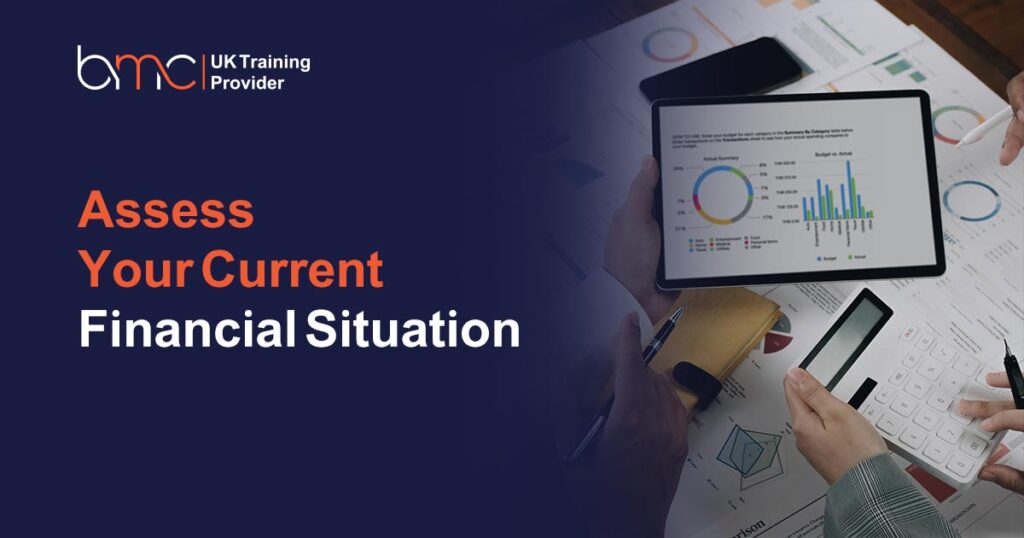Managing money wisely is more important than ever, whether you’re planning for retirement, starting a business, or simply trying to build financial security. At the heart of smart money management lies the financial planning process — a structured approach that helps individuals and organizations set clear goals, understand their financial situation, and take actionable steps toward a more secure future. In this article, we’ll break down each stage of the financial planning process and show you how it can lead to better decisions, stronger financial health, and long-term success.
what is the financial planning process
The financial planning process is a structured, step-by-step approach used by individuals, families, or businesses to manage their finances wisely and achieve their short- and long-term financial goals.
It involves assessing your current financial situation, setting realistic goals, creating a strategy to meet them, and regularly reviewing your progress.
Key Components of the Financial Planning Process
-
Goal Setting – Defining what you want to achieve financially (e.g. buying a home, saving for retirement).
-
Data Gathering – Collecting financial information like income, expenses, debts, and assets.
-
Analysis – Evaluating your current financial health to identify strengths, gaps, and opportunities.
-
Plan Development – Crafting a personalized strategy involving budgeting, saving, investing, and risk management.
-
Implementation – Putting your financial plan into action.
-
Monitoring and Review – Adjusting the plan over time as your life or financial situation changes.
financial planning process
The financial planning process is a structured approach used by individuals, businesses, or financial advisors to achieve financial goals and ensure long-term stability. It involves analyzing current finances, setting clear objectives, and creating a realistic plan to reach them.
✅ Key Steps in the Financial Planning Process:
-
Establish Financial Goals
-
Define short-term and long-term financial objectives (e.g., saving for a house, retirement, business expansion).
-
-
Gather Financial Information
-
Collect data on income, expenses, assets, debts, and current investments.
-
-
Analyze the Financial Situation
-
Assess cash flow, net worth, risk exposure, and identify gaps or opportunities.
-
-
Develop a Financial Plan
-
Create a personalized strategy that includes budgeting, saving, investing, and risk management.
-
-
Implement the Plan
-
Put the plan into action—open accounts, adjust spending, invest, or insure as needed.
-
-
Monitor and Review
-
Regularly track progress, review outcomes, and make adjustments based on changes in income, goals, or market conditions.
-
9 financial planning process steps

1. Set Clear Financial Goals
The first step in personal financial planning process is to set clear, realistic financial goals. These could range from short-term objectives like saving for a vacation to long-term goals such as retirement planning or paying off a mortgage. Goals should be specific, measurable, achievable, relevant, and time-bound (SMART).
Imagine you dream of buying a home. To make this dream a reality, determine you need $30,000 for a down payment in five years. This means saving $500 a month. Setting this specific goal gives you a clear target and helps outline your saving strategy.

2. Assess Your Current Financial Situation
The second step in the personal financial planning process is to take a moment to review your income versus your expenses. If you find you’re spending a significant portion on non-essentials, this insight allows you to identify opportunities for savings. Understanding where your money goes each month is the first step toward better financial management.
3. Create a Budget
The third step in the financial planning process is creating a budget, which is crucial for managing your finances effectively. It involves tracking your income and expenses to ensure you live within your means. A budget helps prioritize spending, control impulsive purchases, and allocate resources towards your financial goals.
With your financial assessment in hand, create a budget that divides your income into necessities, savings, and wants. For example, allocate 50% of your income to essentials like rent and groceries, 20% to savings, and the remaining 30% to personal wants. This structured approach ensures you cover your basics while still working towards your savings goals.
4. Build an Emergency Fund
An emergency fund in the financial planning process is a financial safety net designed to cover unexpected expenses, such as medical emergencies or sudden job loss. Aim to save at least three to six months’ worth of living expenses to provide peace of mind and financial security.
Start setting aside a small portion of your income into a separate savings account for emergencies. Even $100 a month can build up over time, providing you a financial cushion for unexpected expenses like car repairs or medical bills, ensuring you’re prepared for life’s surprises.
5. Manage Debt
As a very important step in the financial planning process, effective debt management is key to financial wellness. Prioritise paying off high-interest debts first, such as credit card balances, while maintaining minimum payments on other debts. Consider strategies like debt consolidation or negotiating with creditors to lower interest rates.
If you have multiple debts, prioritise paying off the ones with the highest interest rates first, while still maintaining minimum payments on others. This method reduces the amount of interest you’ll pay over time, making your debt more manageable and saving you money.
6. Invest for the Future
Investing is essential for growing your wealth and achieving long-term financial goals and a major role for your personal financial planning process. Diversify your investment portfolio to spread risk and consider seeking advice from financial professionals. Strategic investing can lead to significant financial gains over time.
Consider beginning with a simple investment, such as a low-cost index fund, and commit to a regular investment schedule. Even a small, consistent investment can grow significantly over time, helping you build wealth and secure your financial future.
7. Protect Your Assets and Income
If you are seeking insightful financial planning process, then Insurance plays a critical role in protecting your assets and income. Evaluate your needs for life, health, disability, and property insurance to ensure you and your family are adequately protected against unforeseen events.
Evaluate your need for insurance, including health, life, and disability insurance, to protect yourself and your assets against unforeseen events. Choosing the right insurance plans ensures you and your family are financially protected in case of emergencies.
8. Plan for Retirement
Retirement planning is a vital component of personal financial strategic planning. Contribute to retirement accounts like 401(k)s or IRAs to benefit from tax advantages and employer matching (if available). Regularly review and adjust your retirement savings plan to stay on track.
If you have access to a retirement savings plan like a 401(k) through your employer, start contributing as early as possible. Even a modest contribution can grow substantially over time, thanks to compound interest and potential employer matching.
9. Review and Adjust Your Financial Plan Regularly
The last and most important step in the financial planning process is YOUR financial situation and goals will evolve over time, necessitating regular reviews and adjustments to your financial plan.
Annual reviews, or more frequent ones during significant life changes, ensure your plan remains aligned with your current needs and goals.
Life changes, and so will your financial situation and goals. Make it a habit to review your financial plan at least once a year or after major life events. This ensures your financial strategies remain aligned with your current needs and future aspirations.

what is the first step in financial planning
The first step in financial planning is:
✅ Establishing Financial Goals
This step involves identifying and clearly defining what you want to achieve financially—both in the short term and long term. Your goals might include:
-
Saving for an emergency fund
-
Buying a house
-
Paying off debt
-
Funding education
-
Planning for retirement
-
Growing investments
Clear, measurable goals provide direction and help shape the rest of your financial plan. They serve as the foundation for all decisions that follow in the planning process.
the second step in the financial planning process involves tracking what?
The second step in the financial planning process involves:
✅ Tracking Financial Information
This means gathering and organizing data about your current financial situation, including:
-
Income (salary, business earnings, passive income)
-
Expenses (fixed and variable monthly costs)
-
Assets (savings, investments, property, etc.)
-
Liabilities (loans, credit card debt, mortgages)
-
Insurance coverage
-
Tax information
This step provides a clear snapshot of where you currently stand financially, which is essential for building a realistic and effective financial plan.
FAQs on Personal Financial Planning Process
Q: Why is personal financial planning important?
A: Personal financial planning is crucial for managing your finances efficiently, achieving financial goals, and ensuring financial security for yourself and your family.
Q: How often should I review my financial plan?
A: It’s recommended to review your financial plan at least annually or more frequently during significant life events such as marriage, the birth of a child, or a career change.
Q: Can I do personal financial planning on my own?
A: Yes, many individuals successfully manage their financial planning. However, consulting with a financial advisor can provide expert insights, especially for complex financial situations or long-term strategic planning.
Q: How much should I save in my emergency fund?
A: Aim to save at least three to six months’ worth of living expenses in your emergency fund to cover unforeseen expenses.
how many steps are in the financial planning process?
The financial planning process typically includes 6 key steps. These steps are widely recognized by financial professionals and organizations like the CFP Board.
The 6 Steps of the Financial Planning Process:
-
Establish Financial Goals
-
Gather Relevant Financial Data
-
Analyze the Financial Situation
-
Develop a Personalized Financial Plan
-
Implement the Plan
-
Monitor and Review the Plan Regularly
Conclusion
Personal financial planning is a dynamic and continuous process that demands not just commitment but also a keen eye for detail and regular monitoring. The journey towards financial independence and security is nuanced, involving a series of well-thought-out steps and decisions that reflect both current needs and future aspirations.
By diligently following the nine outlined steps—ranging from setting clear financial goals to regular reviews and adjustments of one’s financial plan—individuals can craft a path that is both sustainable and aligned with their personal values and life goals.
Incorporating strategic planning into personal finance goes beyond mere budget management or savings. It’s about creating a vision for your life that encompasses your financial well-being as a critical component.
This approach enables individuals to make informed decisions that not only meet immediate needs but also pave the way for long-term achievements and security. With a strategy in place, navigating the complexities of finance becomes less daunting, allowing for a more confident journey through the various stages of life.
Take a look at the HR training courses in Dubai one of the best courses on BMC.


